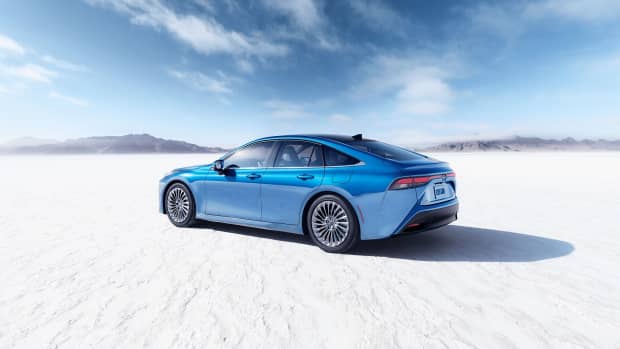The 2021 Toyota Mirai is a fuel cell electric vehicle (FCEV) and Toyota’s TM, -1.22% newest flagship sedan. It won’t cost anything to refuel for about three years and the only emissions are water molecules. On top of that, it’s based on the same refined platform as the Lexus LS large luxury sedan. These are the considerable upsides.
Sadly, the new Mirai is only available in California and Hawaii right now. That’s because this car needs hydrogen to run and most of the few refueling stations are in the Golden State, with one on the island of Oahu.
“Mirai” means “future” in Japanese, a fitting name in light of the fact that hydrogen-fueled vehicles are considered the next step in personal transportation beyond hybrids and battery-powered cars. But plans to expand the supply infrastructure did not progress much in 2020. We could be looking at 2030 before there’s a decent network.

The 2021 Toyota Mirai
TOYOTAEven so, there are still 43 stations on the mainland. Some stretch from San Diego to Santa Barbara by way of Los Angeles, with a cluster in the Bay Area and a few in Sacramento.
At least paying for the hydrogen is taken care of for a while, since FCEV manufacturers throw in a generous amount of free fuel as part of the deal. And refueling only takes about five minutes. Compare that with a typical electric car powered by rechargeable batteries.
If this is anyone’s first foray into fuel cell vehicles, here’s a quick explanation. Hydrogen (stored in pressurized tanks) is fed into a fuel cell, where a chemical reaction creates electricity. This energy is stored in a battery, which powers an electric motor. There’s nothing to plug in. Everything happens under the hood.
At the other end of the fuel cell’s process, hydrogen and oxygen atoms hook up to become H2O, aka water, which is vented away out of the tailpipe. Driving a Mirai through a city center would actually leave cleaner air in its wake.
Hydrogen can be created domestically, using biofuels and/or electrolysis, adding to the Mirai’s overall sustainability. This new second generation of Mirai, which is a major improvement over the first generation, is also a fine illustration of Toyota’s strong commitment to fuel cell technology.
What’s new for 2021?This is a completely fresh generation that debuts for 2021, so virtually everything has changed. Compared with the first generation, the new Mirai is more than 3 inches longer with a wheelbase that’s 5.5 inches longer. That brings benefits in ride quality. It’s also 2.7 inches wider and 2.5 inches lower. Naturally, the styling is also different, this time with more of a high-class Lexus look than its somewhat wacky predecessor.
Maximum range increases from 312 miles to 402. And although the 2021 Mirai has gained 172 pounds, overall weight distribution is an ideal 50:50. And the center of gravity is lower, making the car feel especially stable and balanced.
Accommodation grows from four to five, although that extra seating spot is in the middle of the back seat. Trim levels grow from one to two. Perhaps the most crucial change is that the 2021 Mirai starts out substantially less expensive than before, by $9,050.
Fuel economy
An AC synchronous electric motor develops 182 horsepower and 221 lb-ft of torque. This goes solely to the rear wheels. The motor runs off a lithium-ion battery, which also stores energy harvested from braking.




